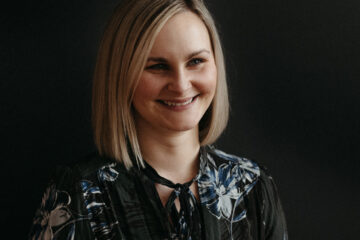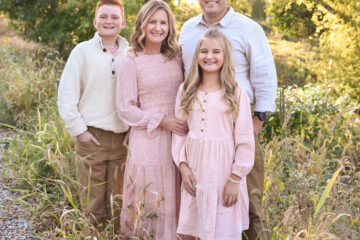By Nicole Paseka Grundmeier

Andrea Arkland with her daughter, Emersyn. Submitted photo
Andrea Arkland gave birth to her first baby at Broadlawns Medical Center in Des Moines. But when she has a second baby someday, she might drive almost 300 miles to her home state of South Dakota so she can give birth in the way she believes is healthiest and safest for her family.
Once a pregnant person has a C-section, hospitals frequently have strict policies about future prenatal care and the way in which that person births. But advocates say these hospital policies can take away choice and bodily autonomy.
Arkland is petitioning Broadlawns Medical Center in Des Moines, Polk County’s public hospital, to change its rules. “This change would not only honor the voices of women but also set a precedent for other hospitals in our community to follow,” reads her planned statement to the board.
During her pregnancy and labor, Arkland received care from certified nurse midwives, or CNMs, at Broadlawns. Her daughter, Emersyn, was born there via cesarean section in April 2024.
Arkland is not allowed to receive prenatal care with the Broadlawns CNMs for subsequent pregnancies. Under Broadlawns’ official policy, Arkland is also not allowed to attempt a vaginal birth after cesarean, also known as a VBAC, at the hospital.
She started an online petition that had just over 400 signatures as of Oct. 8. The petition includes two requests: 1. Allowing patients with a previous C-section to receive prenatal care with Broadlawns certified nurse midwives; and 2. Allowing patients with a previous C-section to attempt a VBAC with Broadlawns certified nurse midwives.
Arkland and other VBAC supporters plan to speak publicly at a Broadlawns Board of Trustees meeting at 4 p.m. Oct. 15 in the Hunsaker Conference Room.
A Broadlawns spokesperson did not return an email and a phone message.
“VBACs save lives, just like C-sections save lives. And there are risks and benefits to both,” said Rachel Bruns, chapter leader for the International Cesarean Awareness Network of Central Iowa, an advocacy group that works to reduce C-section rates.
Often, hospitals ban or limit VBACs because of workforce issues, perceived liability and staff concerns about managing unexpected emergencies. Because a woman who has a previous C-section has a slightly higher risk of uterine rupture, which can be fatal to the laboring woman and her unborn child, an operating room must be closeby and ready, the reasoning goes, ideally including an OB-GYN and an anesthesiologist ready 24 hours a day, seven days a week. Hospitals don’t always have these resources.
Birth advocates argue that families should be fully informed of the risks and benefits of both C-sections and VBACs — and ultimately get to choose the path they prefer. Bruns said American facilities are unusually wary of VBACs. “In any other country, it’s not considered high risk,” she said.
In Iowa, 29.6% of babies were born via C-section in 2022, according to data from the U.S. Centers for Disease Control and Prevention. The World Health Organization considers the ideal rate of C-sections to be between 10% to 15% of births. The C-section rate has exploded in recent decades in the U.S. and other parts of the world.
Bruns said: “Depending on where you live in the state, it can be extremely challenging to find care that is providing you with the full breadth of information on what those risks and benefits are for both repeat cesareans and VBAC.”
Arkland said she initially sought prenatal care by the CNMs at Broadlawns because she wanted a natural approach to pregnancy and childbirth. Arkland said the midwives listened to her, gave her choices during her pregnancy and were respectful of her decisions.
At 42 weeks gestation, the CNMs recommended induction. The CNMs gave Arkland a choice — she could undergo a chemical induction or a balloon catheter method. She chose the latter. She was in labor for days with little sleep. Her labor progressed, and her cervix fully dilated. However, Arkland pushed for more than six hours without the baby moving past her pelvis.
“I do remember taking a break, sleeping for a little bit. And then they came back in and were like, ‘OK, let’s try this again.’ And they’re like, ‘Just to warn you, if things don’t progress, you might want to think about a C-section,’” Arkland said. “And so we tried pushing for a while yet, and still nothing.”
The midwives told her that her only other option was a C-section because the baby was clearly not coming out. An OB-GYN performed the surgery. CNMs do much of the same work that OB-GYNs do in terms of care during pregnancy, birth and postpartum, but they do not perform surgeries.
Arkland said that, while she doesn’t want to bash OB-GYNs, she prefers the more natural, empowering care model offered by certified nurse midwives. She also believes that being under the care of a CNM would lower her risk of a repeat C-section with her next birth.
Although viewed by many as routine, a C-section is major abdominal surgery. Repeat C-sections in particular increase complications — life-threatening problems with the placenta, including placenta accreta, adhesions, hernias and more.
Truly supportive providers of VBACs in Central Iowa can be difficult to find in hospitals, although some providers are VBAC tolerant, said Bruns, the ICAN of Central Iowa chapter leader.
VBAC bans can push pregnant people to seek out-of-hospital birth options with wildly varying degrees of safety. Certified nurse midwives (CNMs) have different education and training than certified professional midwives (CPMs) or traditional/lay midwives — but the public often does not know about the differences. There is also a trend among some women of “free birthing” — attempting to birth at home without a medical provider of any type present. Influencers on TikTok and Instagram share their “wild pregnancies” and free births online and encourage their followers to do the same.
Some Central Iowa women who want to attempt a hospital VBAC are traveling to Iowa City, Omaha, Neb., Sioux Falls, S.D., the Twin Cities or other locations to find truly VBAC-supportive providers, Bruns said. This creates an economic barrier with care. Women who are able to afford travel, hotel expenses and time off work can find VBAC-supportive providers. Low-income women often cannot.
Because a woman who has given birth previously by C-section has a slightly higher risk of a uterine rupture, C-sections are not ideal for many women, especially those who want larger families.
Arkland and her husband would like to have four children. “I really, really, really wanted to have a VBAC with Broadlawns, because I loved the care there, I loved the aftercare there after we gave birth to her, I loved the pediatrician there. We have had no issues besides the birth not going 100% as planned,” Arkland said. That affinity, coupled with what she learned about the viability and potential advantages of a VBAC, prompted her to become an advocate.
“If we don’t like the options here in Des Moines, why has no one spoken up or done anything about it yet?” she said. “Why are we just sitting here being OK sacrificing the care we want and deserve?”
Arkland said she knows of women in her hometown of Sioux Falls, S.D., who have had successful VBACs there with CNMs. If she can’t find a truly VBAC-friendly provider in Central Iowa, she might give birth there — but that would require her to travel, take extra time off her job and find child care for Emersyn.


